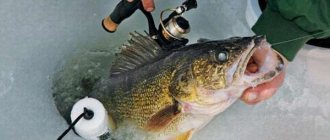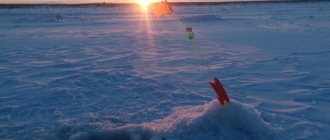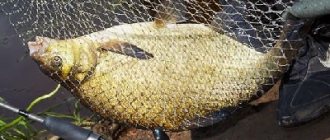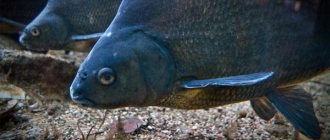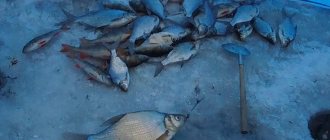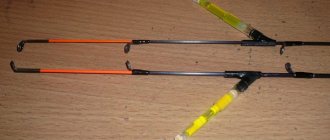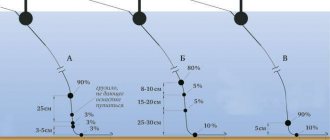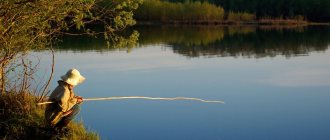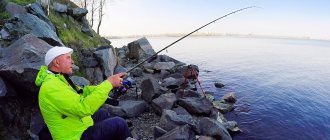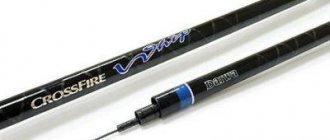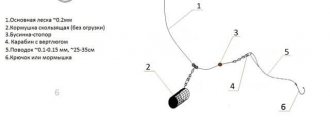The article talks about catching bream with side rods on the reservoir. The important aspects of fishing, bait, gear layout, feeding features and other important nuances are covered.
It’s worth noting right away that onboard fishing is not very widespread in all the reservoirs where I’ve been. There have been approximately the same number of onboard boats in recent years. Apparently, this is a stable circle of fans of onboard tackle, and other fishermen are not particularly eager to join their ranks. Although in winter almost everyone fishes from the ice with almost the same gear and similar techniques.
Reasons for the low popularity of onboard tackle
So why don’t many people practice airborne? I see three possible reasons. The first is that they don’t believe in its capabilities. Here, until you try it yourself, you won’t be convinced. I, too, used to be very skeptical about this method of fishing, but now I’ve changed my opinion for the better. The second reason is the sharp increase in the popularity of modern float fly and match fishing, which people enjoy fishing not only from the shore, but also in a boat. I will not compare the possibilities of summer float fishing and onboard fishing. I will only note that if the latter had lost even a little in bream catches, this ancient tackle would have long since gone into oblivion, because everyone has float rods. I think there are other reasons here, ranging from “in the summer you need to fish with summer gear, which is promoted by modern float fishing” to a simple fisherman’s “I like it better.” And for me, it’s just more pleasant to fish with onboard gear, while I’m sure that I won’t catch more or larger bream with summer float gear. And the third possible reason for the low popularity of onboard fishing is that despite the external similarity of winter and summer vertical fishing, onboard fishing has its own characteristic features, without taking these into account, it is problematic to successfully transfer ice experience to fishing from a boat.
Advantages and disadvantages of homemade onboard fishing rods
The flanges have a short fishing rod and are used for vertical fishing from a boat. Since fishing often takes place behind the fishing line, the fishing rod takes almost no part in casting, so any material is used for its manufacture. Main advantages:
Although onboard products have many advantages, problems can arise when fishing for bream, since they are designed for greater depths. If the depth of the reservoir is less than 2 m, it will be difficult to catch bream in such a place. The fish is frightened not only by the noise emanating from the boat and the fisherman, but even by its shadow.
Another drawback of the flange is the difficulty of fishing during waves. When waves appear, the boat begins to sway and it becomes difficult to monitor the bite. Because the fishing line located between the alarm and the hook must always be in a taut state.
For such weather conditions, there are specially designed onboard fishing rods on sale that are equipped with bite alarms.
Differences from winter fishing
I like to catch bream in winter. Comparing ice and summer boat fishing, I see the main difference - when onboard fishing, it is impossible to achieve absolute immobility of the boat and, accordingly, the gear. This winter you sit confidently, clearly fixing the tackle and hook with bait, over and over again lowering it onto a nickel of bottom soil no larger than a matchbox. I also point feed, opening the feeder at the very bottom. In winter, there is an opportunity to play along with a jig. And even the wind is not very dangerous for the operation of the nod; it can always be neutralized by sitting with your back to it, or hiding in a tent. But sitting in a boat, you won’t be able to fish like that. Perhaps, in absolute calm, no special problems are expected, but on reservoirs, the wind, at best, wrinkles the water, and at worst, drives a decent wave. As a result, no matter how you anchor the boat, you won’t be able to fix it absolutely motionless, which affects many aspects of fishing.
Tackle for catching bream on a feeder in the current
Despite its rather large size, bream is not a fish that offers strong resistance when fishing, so feeder gear for bream is selected based on fishing conditions.
In rivers, bream prefers places with great depths and moderate currents; in addition, it rarely comes close to the shore. To catch it, you need to choose a heavy-class feeder with a maximum weight of the cast feeder of 120-150 g. The feeder length is from 3.6 m to ensure the required casting distance.
The rod is equipped with a spinning reel size 3500-4000 according to the Shimano classification. Considering the weight of the feeders, the reel must have good traction characteristics, and the use of thin leads requires high-quality operation of the clutch. If carp lives in the place where bream is caught, it is advisable to have a baitrunner system.
In such fishing, only braided fishing line is used to ensure the necessary sensitivity of the gear and reduce the drift of the feeder by the current. Line diameter – 0.14-0.18 mm. If necessary, use a shock leader - a piece of thick fishing line 2-3 m long longer than twice the length of the rod. It takes on the load that occurs when casting, preventing the equipment from “shooting”.
The main rigs for catching bream in the current are an asymmetrical loop and a Gardner paternoster.
There are several ways to catch bream on a feeder
The leash can be made from regular fishing line with a diameter of 0.12-0.20 mm or fluorocarbon with a slightly larger diameter. The use of fluorocarbon is desirable in places where the bottom is covered with zebra mussel colonies. The length of the leash depends on the biting activity - with a large number of empty bites, the length of the leash is increased, and in cases where the fish swallows the hook deeply, it is reduced. With the optimal length of the leader, the fish is caught at the edge of the lip. Fishing usually starts with a leash length of about half a meter.
Feeding process
There are no big problems, just like in winter from the ice, feeding point-wise in order to activate the fish’s bite. But it won’t be possible to fish exactly along the compact stern spot - no matter how you pull the anchor halyards, no matter what angle you let them in, the boat still drifts a little to the left and right along the guy ropes. If the wind changes, the boat will shift slightly in the new direction of the wind. Accordingly, there is no point in feeding compactly in order to fish somewhere away from the bait spot. But you don’t want to scatter the food too widely, because this will disperse the fish. And I usually try to place the bait in a spot with a diameter of 1-2 m; I choose a specific option depending on how much the boat is rocking today. I try to form the spot so that the bait approximately falls into its center. Starting feeding is five times more than in winter. So, if I immediately lower one full standard feeder from the ice into the hole, then in the summer there will be at least five. A large amount of food in open water is in itself good for collecting and retaining fish, and also allows you to properly feed the required bottom area.
Fishing
The winter experience of fishing for bream, with hand-pulling the line, is largely in demand when onboard fishing, where I fish in the same way, putting the rod aside after hooking. Yet there are two differences in this matter. The first is pleasant, due to the fact that when the bream is brought to the boat, in the water, all its movements are visible in the palm of your hand. In winter, especially if the ice is cloudy or covered with snow, I only see bream lips, and then only when I have already brought the fish into the hole, and before that everything is done by touch. The second feature of fishing is that the process is more complex than in winter. In open water, problems with large bream often arise when I bring them to the upper layers of the water. He often starts playing in circles and goes under the boat. It can pretend to be completely exhausted, but as soon as you start to bring it into the landing net, the bream turns around and powerfully tears to the side or down. And so, it happens, he mocks him two or three times until he ends up in the landing net. Of course, it would be useful to tire the fish somewhere closer to the bottom, but it will scare away the whole school there. And immediately after hooking, a side fishing rod cannot, due to its design, move it away from the baited area, as a float rod or feeder can do. And at any stage of fishing I can’t force it, because in winter and summer I fish with a fairly thin line of 0.12 mm (real diameter), which usually gives more bites, and they are more confident, compared to thicker equipment.
What does the tackle consist of?
For fishing, specialized fishing rods are selected, the length of which does not exceed 1 meter. Spinning rods for fishing from a boat can be plug-in or telescopic. In any case, the fishing rod should not cast long distances, because fishing is done “under your feet.”
The rod is equipped with a light inertial reel. As a rule, a clutch on a side rod is not required unless we are talking about catching a trophy, for example, carp. The diameter of the main line is selected according to the fishing location. Usually it does not exceed 0.25 mm.
Installing 2-3 rods increases the chances of a bite. If fish activity is high, excess gear can be removed. 2-3 fishing rods allow you to experiment, try different baits and fishing depths, and installation.
The signaling device is a nod made of twisted steel wire with a plastic ball at the end. When fishing from a boat, high-frequency play with bait is not required, so the main task of the nod is to convey the bite and be noticeable.
Equipment Variations
The choice of installation depends on the depth at the fishing point, the structure of the bottom and the weight of the intended catch.
On a pebble, sandy or shell bottom, use the following type of equipment:
• An olive weighing up to 3 grams is threaded onto the main line. • The sinker is supported with a bead or silicone stopper. • Next, the leash is mounted using the “loop-to-loop” method. • To catch small fish, several hooks are used, but bream, large crucian carp or carp can break the tackle if a free hook gets caught on an obstacle.
On a muddy bottom, the rig looks a little different. A sinker with an eye is tied to the end of the main line, then a loop is tied at a distance of 30-50 cm from it. A leash is attached to the loop, the length of which does not exceed half a meter. The sinker sinks into a soft layer of silt, and the hook with the nozzle remains on the bottom surface.
Float installations are used extremely rarely; in this case, you can get by with the two above-mentioned equipment, replacing the nod with a classic signaling device.
With one fishing rod
If in winter, when fishing for bream from ice, I can put out several fishing rods without any problems, then I fish from the side of a boat with only one tackle. After all, I don’t experiment much with bait, relying on a reliable, repeatedly tested bunch of bloodworms. In some places it can be useful to add maggots, but this is not the kind of variety that forces you to put out several fishing rods at once in order to quickly figure out the best bait for today.
I don’t see the need to fish with several gears in order to figure out the coolest horizon - usually bream in the reservoir either takes it from the bottom, or doesn’t take it at all. And most importantly, active fishing with one fishing rod allows you to significantly better control the entire fishing process, especially when the wind blows the boat. And after successful hooking, there is no need to worry that the bream will have time to get tangled in the equipment of the second fishing rod.
Best fishing spots
They say that bream points for fishing with onboard tackle often coincide with winter ones, and then ice experience is a great help when searching for fish in open water. Things work out a little differently for me. In winter, the main bream depths where I fish are no more than 5-5.5 m. But in open water I fish in completely different areas, although the depths are almost the same. This is an almost flat plateau, there are just regular drops of ten centimeters up and down. The bottom is soft, the anchor is covered in a black mess, there is no grass. That is, a vast, uniform area along which the bream most likely moves widely, and there is no need to find a point that worked well before on the next fishing trip. But where can you not return to where the bream pleased you with the bite last weekend! Therefore, I enter a place into the navigator and stand on the stretchers approximately in the same place where I fished earlier. Although it is quite problematic to become absolutely perfect, especially in the wind - by the time you figure out the stretch marks, you will be wrong by 3-4 meters.
Onboard bottom fishing rod equipment
For fishing in strong currents, you need a heavy feeder weighing up to 250 grams for strong currents and a strong side rod, preferably with a whip, on which there is room to install a guard. The guard nod is most often made of a flat metal spring, at the end of which a plastic or foam ball painted in a bright color is glued. A wire bow is attached at the bottom so that the bell can be hung. Feeder bells are also now used as bite alarms.
The reel can be either a wire reel, which is used in the equipment of telescopic fishing rods, or a spinning reel. In the first version of the rig, the reel is used only for winding the fishing line, and the fish are caught by the fishing line. And here there are pitfalls... A fishing line carelessly dropped to the bottom of the boat often gets tangled. Therefore, it will be easier and faster to catch without inertia. But at the same time, conventional inertial reels are also quite successfully used for fishing on side donks.
For fishing with onboard fishing rods, it is best to use a braided cord , since fishing takes place in a strong current, where the monofilament line will stretch too much and sail. It has great stretchability. Braided line, on the contrary, is a fishing line that has absolutely no elasticity and seems to cut the oncoming jets of water. In addition, at great depths and currents, a braided cord more accurately and sensitively indicates the bite. A cord thickness of 0.15-0.17 mm will be quite enough for a massive feeder and resistance to flow.
It is better to make leashes from monofilament fishing line with a diameter of 0.2 mm. The length of the leash is quite significant and depends on the activity of the fish. If the bite is good, a leash 0.7-1.0 m . To catch inactive fish, they make something like an undergrowth, where the length of the main leash of the undergrowth is about 3 m No. 8-6 of international numbering are tied to it .
Time of day
Compared to winter, the daily fishing period is quite short. In winter, I often fish at night, and even during the short winter day there are periodic outbreaks of biting. In general, you can feed the point, relax and, having gone out for the night, calmly wait for the fish to approach. With onboard gear, fishing is more dynamic, often only taking place in the morning hours.
The first bites for me usually begin an hour and a half after dawn - until you feed, until everything on the bottom settles down, until the fish approaches and the main peak of the bite begins. Something else may continue to hatch, but after 10 o’clock there was never much bite, and I sit until lunch at the most.
Important features of onboard gear
Nod or float. The choice in this important issue depends not only on personal skills and habits, but also on real conditions. Based on my own experience, I will say: in winter I can play along with bait, and here I can’t do without a nod, but on board fishing I never play along, and the need for a nod disappears by itself. The conclusions here are simple - why it’s bad to play along crookedly, it’s better not to do it at all. I can also admit that playing along is useful when fishing in a calm state or in a very light breeze, when the boat is almost motionless. But I don’t remember fishing trips when I found myself in such conditions on a reservoir - a constant wind of 5-6 m/sec, a wave, plus a small current.
At the same time, the boat is in perpetual motion up and down, and even if this amplitude is not so large, it is sufficient to disrupt the play of the jig fishing rod, no matter how hard you try to play along carefully. Such disruptions and sudden movements may be suitable for perch, but bream is a more cautious and respectable fish. That’s why I use a float rig, and since I don’t need to play along, I don’t see the need for a jig. I tie a high-quality hook No. 14 to the fishing line, one weight is clamped on the fishing line of 3-4 cm, everything is simple, traditional, but I’m experimenting with the float.
Now about how to anchor correctly
On the eve of fishing, I always listen to the weather forecast on the radio and try to find out the direction of the wind. If there is a breeze in the morning, then I lower the bow anchor to the maximum length of the halyard. Then I wait until the boat is positioned exactly downwind and lower the stern anchor. I pull up the bow halyard and secure it so that it is securely on the stretch.
If there is no wind, then after lowering the bow anchor and its halyard to the maximum length, I take the oars and position the boat in the predicted wind direction. Nowadays, weather forecasts are rarely wrong, and the boat, as a rule, can be positioned correctly. I lower the stern anchor and tighten the bow halyard.
All that's left to do is choose a fishing spot.
It's not easy to catch big bream. He is cautious and timid. But there are still ways to do this. One of them is fishing with a side rod with a nod. In this article I describe fishing for bream from a boat in bodies of still water.
The gear for this kind of fishing is very simple.
In fact, this is a winter fishing rod with minor differences. You can buy a special fishing rod, about 0.7 m long, equipped with a simple reel for storing fishing line. Or you can take an ordinary winter fishing rod and attach a whip from a fiberglass telescope to its handle with electrical tape. That's all the rod is.
The only requirement for the whip is that it must be hard, since it only takes part in the game of bait and hooking. Fishing is done by hand. I use main line from 0.15 to 0.22. It is not worth using a thinner line because it is inconvenient to use. Since the likelihood of beards increases when choosing gear. After all, the fishing line has to be stowed in the boat. Greater thickness is not recommended, as the tackle becomes too rough.
A leash of 0.13-0.14 is possible, but not required. The length of the leash is about 0.5 m.
When fishing with two hooks, there is a danger of the free upper hook catching on the boat when landing the fish, and the threat of it getting off. Therefore, in the absence of the necessary dexterity and experience, it is better to fish with gear with one hook or jig.
The last part of the tackle is the nod. The nod for summer fishing is longer and more powerful compared to the winter version. Selected empirically. It should not sag much under the weight of the bait and allow for a smooth game. I use lavsan nods and metal ones made from a watch spring.
The next necessary part of preparing for fishing is preparing bait.
The best bait Sometimes, with the addition of maggots. There should be a bunch of 3-4 worms on the hook. In some reservoirs, large bream can also be caught using bloodworms. But it is difficult to use in summer. The hooks are too big, and it is difficult to keep bloodworms in warm weather. It also sometimes bites on pearl barley, but it’s worth fishing for it only if you’ve run out of animal baits.
So, gear, groundbait, bait - everything is ready to go.
The best weather for catching bream in the summer with a side fishing rod is, oddly enough, a stable anticyclone, with a weak wind, heat and sun. It is on such days that bream stays in the cool depths during the day. Although quiet cloudy weather is also good.
The best fishing time is from July to October. And of course, people don’t go fishing for a good bream for one day, without spending the night.
Tips for fisherman: Catching grayling in the spring with a float rod - Features of choice
All that's left to do is choose a fishing spot.
Bream do not like to stand in the pits themselves in summer.
If everything is in order with the place, then you can start feeding it.
Before this, you need to anchor the boat with guy wires.
Now I will describe the technique for setting the boat up.
A few words about the boat.
It can be anything, but it’s better not to fish from metal and plastic longboats. It is difficult to maintain silence on them while fishing. And the larger the sail of your boat, the more inconvenient it is to fish from it. For ease of fishing, many fishermen install seats from old Zhigulis in their boats. It is difficult to sit for many hours on ordinary benches without a backrest.
Complementary food can be delivered under the boat using a feeder (an enlarged version of the winter one) or simply scattered around the boat. Some bodies of water have strong undercurrents. Feeding with a feeder is preferable on them.
I usually fish with two fishing rods.
The best bite is usually from 4 to 9 am. But it can bite even before lunch. After 15 o'clock the bream rarely bites. On the first day, the bream may not bite at all or bite weakly, but on the second day the bite is usually better and the fish are larger. If you fish for several days, then additional feeding (1 kg of peas) should be done in the evenings.
To store fish while fishing, I use a fabric cage about 1.5 m long. Although many sources write that storing fish in water scares away others, I have not noticed this. Still, it’s usually far from the bottom. However, when fishing at a depth of 5-6 m, it is still better to store the fish in a boat.
After finishing fishing, do not forget to get the anchors. Don't pollute the pond. If the load is stuck in the mud, use the gradual rocking method.
Good luck to you in this exciting activity - onboard fishing!
Bream is an omnivorous species of fish that can take an interest in virtually any bait of plant or animal origin. Usually it bites well on dough with the addition of a small amount of natural honey, various insects or their larvae.
Feeding the chosen fishing spot is one of the most important stages, since the bream remembers the places where a large amount of food was found and then often returns to them.
It is recommended to prepare bait mixtures that combine ingredients of plant and animal origin; they are especially effective in the summer, when the main growth of fish is observed, which contributes to more active consumption of food.
One of the recipes:
An alternative option for preparing a bait mixture to attract bream:
6. Rod “Ob”: a reliable compact rod consisting of two sections. Designed for fishing with light equipment. Equipped with guide rings and a neoprene handle. Length – 0.9 m, test reaches 12 g.
Float nuances
Now I fish with a double float, the same one that many people use when fishing from ice, completely submerging both alarms under the water. The lower one is larger, designed to neutralize the main weight of the load. The top one is a signal one, small, and even when it floats up completely, the bream does not spit out the bait, because the bottom float is always submerged.
I plan to experiment with other options, including with one float, also sinking it, maximizing the sensitivity of the equipment, which floats whose antennas protrude above the water lack. I conduct the main experiments for better visibility of the bite, because with rough water and even small ripples, the float is not always clearly visible, because it regularly begins to be pulled under the boat, or, conversely, away from it. You have to use a fishing rod to return the float to its place. Of course, this problem can be solved radically - by dramatically making the equipment heavier by placing a massive load on the bottom. Maybe somewhere on reservoirs with unafraid bream this technique will work, but on reservoirs that are under considerable pressure, it is very useful for the bream rig to be delicate, light, almost “roach-like” not only in winter, but also in open water, only then can confident swimmers bites even during periods when the fish are not very active.
By the way, about the visibility of the float. I myself do not have very good eyesight - a typical difficulty for many floaters who have similar problems, which makes it very difficult to observe the float when fishing with a long stroke, during match fishing. You have to install large floats with thick antennas, with bosses on thin antennas. All this reduces the sensitivity of the float equipment, but floaters are forced to do this so that the float is clearly visible and bites are not missed. Onboard fishing solves the problem radically - the float is nearby, but I submerge it no more than 1-2 cm from the surface, for greater visibility. Although I don’t deliberately play along with the bait, the play is still present beyond my desire - precisely at those moments when the float is pulled together, and I return it to its place. After all, at this time the entire equipment is moving, and the slow movement is transmitted to the hook with a bunch of bloodworms. Whether this is useful for catching bream or not, I don’t know - the fish are caught, and that’s fine. I know for sure that the bite is much worse with rough equipment, even if the bait doesn’t move. So let it pull, but it will bite.
When and how to properly catch bream on a float rod
Bream fishing in open water begins in early spring, as soon as the ice melts. But the early spring bite before spawning is short-lived, despite the fact that the fish, hungry during the winter, take very well and the catch can be very successful. Already in the spring on the river, when the fish are walking, catching bream with a fishing rod can be successful in not very deep places with a flat sandy bottom, and of course using bait.
Fishing tips: Handmade winter trolling rods - How to best use them
When catching bream with a fishing rod, there is no need for the float to be deeply immersed and stand upright; it is better if it is slightly inclined. So in calm weather you can see the subtlest bite, even the sinker moving from its place, and not just raising the float upward, which is a characteristic bream bite.
The boat should not sway noticeably, much less move. There are several ways to securely secure a boat in a fishing spot, but they are all based on the principle of guy lines. Depending on the strength of the current and wind, I use two or three anchors on nylon guy ropes.
It is not easy to catch a large bronze beauty; bream is shy, distrustful and very careful. There is practically no chance that he arrived and immediately caught a bream. In addition, fishing from the shore is futile here; you need a boat. And besides this, catching bream requires not only certain gear, bait and bait, but also knowledge of the bottom topography to select a fishing area, as well as long-term feeding of the selected place. Content:
CHOOSING A FISHING PLACE
One thing is clear - you need to look for bream sites. Therefore, I highly recommend not to rush, but to spend an extra hour searching for a promising place for catching bream, rafting downstream, especially if you plan to fish for several days. It would be very nice to use an echo sounder, but if you don’t have one, you should carefully examine the shore and the border of aquatic vegetation, which will indicate where to start taking depth measurements.
When taking measurements and remembering promising points, it is better not to rely on any landmarks on the shore, because everything is so changeable on the water, but to immediately mark such places with small weights with buoys, prepared in advance before sailing. A perfectly acceptable option would be a piece of soft cord 10 meters long with a weight and a PET bottle as a buoy.
The cord is connected at one end to the neck of the bottle, the other to the load, and the entire supply of cord is wound directly onto the side surface of the bottle. When a promising point is found, this entire simple structure is simply thrown overboard, while the load rushes to the bottom, unwinding the cord. With this type of self-reset, tangling of the cord is practically impossible. Several such signaling devices will help to identify promising places and choose the “best” one from them.
BOAT INSTALLATION
The boat should not sway noticeably, much less move. There are several ways to securely secure a boat in a fishing spot, but they are all based on the principle of guy lines. Depending on the strength of the current and wind, I use two or three anchors on nylon guy ropes.
WHAT DO WE FEED, WHAT DO WE FISH WITH?
Cooking peas in a regular saucepan is troublesome and takes a long time, so I do it easier - I cook the peas in a pressure cooker. For this case, my “kulak farm” has a 5-liter industrial pressure cooker. Cooking peas in such pressure cookers is much faster. So, in a 5-liter pressure cooker, peas are cooked to the desired condition within just 15 minutes after boiling.
!If fishing is carried out over several days or even weeks, cooking peas is most reminiscent of a conveyor belt - in the morning, before going fishing, I filled the dry legumes with water, during the day I boiled the swollen peas in a pressure cooker, before the evening dawn I took the finished peas out of the pressure cooker and again overnight I poured water over the dry peas, which were to be cooked after dawn.
It would be a good idea to experiment with the color of the nozzle and flavors. On the last fishing trip, for example, a large roach could not resist pearl barley, which was painted bright red with food coloring when boiled. Beyond competition for roach is barley flavored with fragrant honey. I successfully caught bream using a bait that had a faint aroma of anise and vanillin. But the smell of garlic seems to be not to the bream’s taste. In general, you need to try everything. And now, finally, you can start fishing.
WHAT DO WE FISH?
The reel is intended only for storing a supply of fishing line; it does not take part in casting bait and landing fish, so it can be of any type. I prefer light-throwing wire-type reels that have a stopper and trigger. With such reels, it is very convenient to adjust the length of the line at the fishing spot, achieving the optimal position of the sinker near the bottom. It is desirable that the reel be strong enough so that when it moves freely, it unwinds itself under the weight of the sinker.
The main line on the reel is 0.14 mm, maximum 0.16 mm. It doesn’t make sense to bet less, because fishing is done by hand, and a fishing line of this diameter is not the same as bream, but it doesn’t scare small roach either.
Equipping a side fishing rod with weights is somewhat different than equipping a float fishing rod - only the main sinker is available, there is no additional weight. Depending on the strength of the current, the mass of the sinker varies from 1.5 to 5 g.
The downward deflection of the guard under the weight of the sinker is approximately 40 degrees relative to the horizon line. And, of course, the guard must be able to change the length of the working part, adjusting to the weight of the sinker to achieve the optimal bending angle.
If the length of the guard is up to 120 mm, you can safely refuse additional passage rings for fishing line on the guard plate, but if its length exceeds the specified value, then one passage ring located in the middle part of its plate is still appropriate. It is desirable that such a passage ring be able to move along the nod plate. This will make it easier both when transporting the fishing rod and when setting it up in preparation for fishing.
Tips for a fisherman: How to assemble a fishing rod for winter fishing - Choosing the best
A FEW TIPS
In addition to the obligatory accessories - an extractor or a medical clamp for removing the hook from the fleshy lips of the caught fish - the boat should have a landing net with a short, up to one meter handle, preferably with a fishing line so that the sinker and hook do not get tangled. With such a landing net it is not only more convenient to take fish from the water, but also to carry out further manipulations to remove the hook and lower the fish into the net without bringing it into the boat, which will help keep the “workplace” and clothes clean.
If you have a steady hand and strong nerves, you can do without a landing net, taking the fish out of the water by the head. As I already noted, the hooked bream goes to the surface quite calmly, without making circus somersaults, as often happens when fishing in shallow water. On the surface, after taking a breath of air, the fish freezes for a few seconds, and at this moment you can safely pick it up with your hand. But I still prefer a landing net. No tail, no scales!
Forgot your password? Enter your email address. You will receive an email with a link to reset your password.
Forgot your password? Enter your email address. You will receive an email with a link to reset your password.
Once registered, you can ask and answer questions and earn money. Read the rules, we will be glad to see you among our experts!
- Interesting Facts
- 10% from referrals
- Earnings on Vamber
- TOP authors
- Work without experience
Once registered, you can ask and answer questions and earn money. Read the rules, we will be glad to see you among our experts!
Fate has developed in such a way that for the last thirty years the main “testing ground” where I hunt for bream has become the nearby reservoir. In the summer, as a rule, I fish from a boat and always with a float rod. Somehow I don’t recognize bottom tackle, my passion is a float, although they say that a feeder is a more catchy bream tackle. But I don’t believe in this, and I don’t like watching a bunch of fishing rods placed along the shore.
Choosing a fishing rod
For me, the choice is directly related to the same float - when it is carried away from the starting point, returning it to its place with the movement of a fishing rod, which should have the length that allows you to return the equipment conveniently, quickly, and easily. This cannot be done with an ordinary standard winter fishing rod, since you will have to work too widely with your hand, bending somewhere, in general, is inconvenient. It’s more convenient for me to work with a fishing rod a meter long. Otherwise, nothing is required from it, because it’s just a mount for a small reel, and after hooking, the fishing rod doesn’t really work anymore. And while waiting for a bite, I usually don’t hold it in my hand, but put it on the side of the inflatable boat. So the choice here depends on personal preferences, which are varied; accordingly, the onboard fishing rods themselves differ significantly from one angler to another.
Onboard – solo fishing
Many experienced fishermen who love to fish with side rods say that they always fish alone, and if they fish with a partner, they are separated from each other by several tens of meters. And I understand their position. So, when my friend and I are chasing mugs for pike perch, the two of us in a boat are a nice thing, everything goes better with four hands. But if we catch bream with onboard fishing rods, then everyone fishes from their own boat, and we also disperse a little. Still, this fishing requires solitude with your gear and fish. Any unexpected movement of a partner is transmitted to the boat, affecting my tackle, and in the same way I, albeit a little, disturb my friend, this is especially noticeable when the boat is small. Maybe on a large river, where they fish from the side with heavy sinkers, it doesn’t matter how many people are sitting in the boat, but on a reservoir it’s important.
The onboard fishing rod does not like other gear
If we talk not about catching leucorrhoea in general, but specifically about bream, then in my experience, onboard fishing is rarely successful if you start being distracted by other gear. In winter, when there is no bream bite on baited holes, you can place bets somewhere nearby on pike perch or pike, and use a jig to go to smaller places, looking for roach or perch. Onboard tackle requires concentrated fishing with it, its essence is such, and the period of daily fishing is short, there is no time to be distracted. As you know, according to the old classics, a bream fishes a place that is important for several days, generally for the shortest possible period, usually at dawn, when a significant catch is taken in a few tens of minutes, if the flock has approached. If it’s not there, then tomorrow will come – the fisherman will definitely check his treasured point.
Catching pike perch with a spinning rod in snags
Fishing for tench and crucian carp in the swamps
Wiring fishing on a small river
